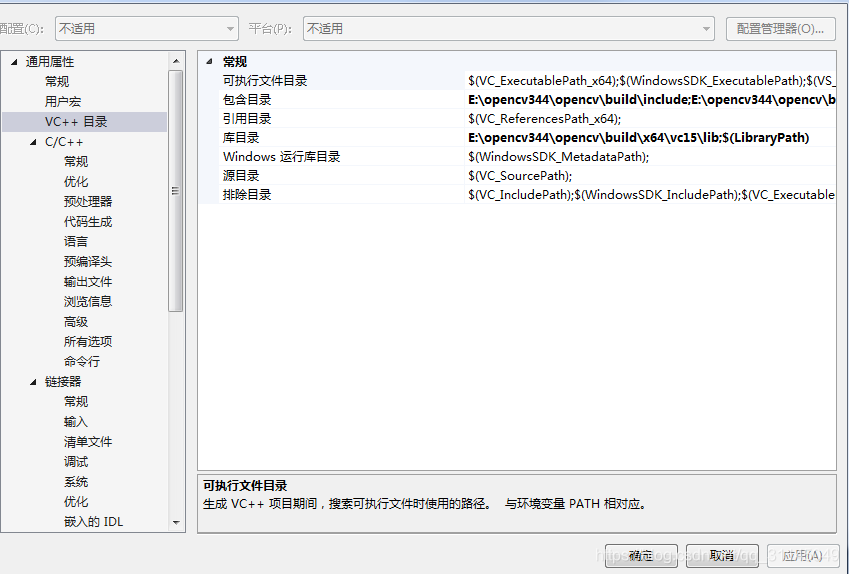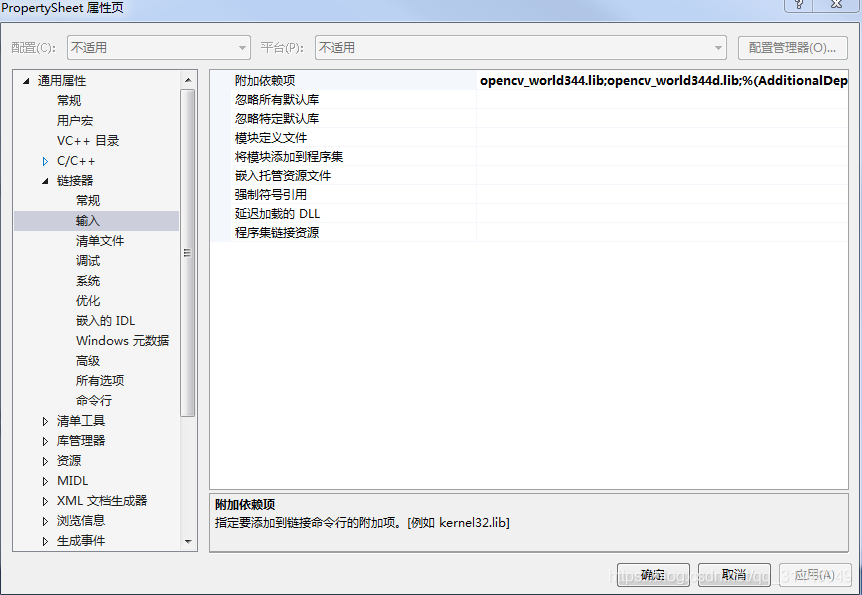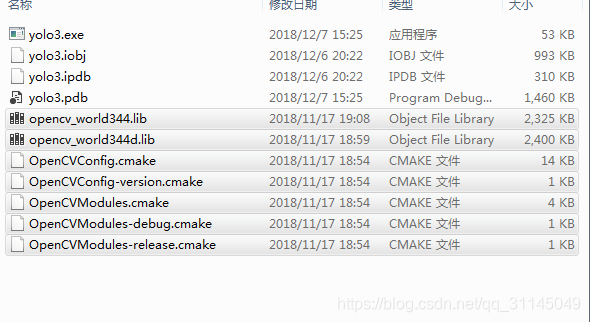windows环境下的YOLO3入门,及opencv344配置
首先
建议使用vs2017以及opencv3.4以上的版本,因为yolo3只有opencv3.4.3(我记得这这个版本以上。。。)以上的版本才能正常调用。
关于opencv3.4以上版本的配置问题,可以参考这篇博文https://blog.youkuaiyun.com/biaobro/article/details/79141868
我们可以把目标检测看成是目标定位和目标识别的结合。
在传统的计算机视觉方法中,采用滑动窗口查找不同区域和大小的目标。因为这是消耗量较大的算法,通常假定目标的纵横比是固定的。
早期的基于深度学习的目标检测算法,如R-CNN和快速R-CNN,采用选择型搜索(Selective Search)来缩小必须测试的边界框的数量(本文的边界框指的是,在预测到疑似所识别到的目标后,在图片上把对象框出的一个矩形)。
另外一种称为Overfeat的方法,通过卷积地计算滑动窗口,以多个尺度扫描了图像。
然后有人提出了快速R-CNN算法,使用Region Proposal Network(RPN)区别将要测试的边界框。通过巧妙的设计,用于目标识别的特征点,也被RPN用于提出潜在的边界框,因此节省了大量的计算。
然而,YOLO使用了完全不同的方法解决目标检测问题。它将图像进行神经网络的一次性正向处理。SSD是另外一种将图像进行神经网络一次性正向处理的方法,但是YOLOv3比SSD实现了更高的精度,同时又较快的运算速度。YOLOv3在M40,TitanX和1080Ti这类GPU上实时效果更好。
为什么选择OpenCV的YOLO
这里有三个理由。
容易整合到现有的OpenCV程序中:如果应用程序已经使用了OpenCV,并想简单地使用YOLOv3,完全不需要担心Darknet源代码的编译和建立。
OpenCV的CPU版本的运算速度比Darknet+OpenMP快9倍:OpenCV的DNN模块,其CPU运行是十分快的。举个例子,当用了OpenMP的Darknet在CPU上处理一张图片消耗2秒,OpenCV的实现只需要0.22秒。具体请看下面的表格。
支持Python。Darknet是用C语言写的,因此并不支持Python。相反,OpenCV是支持Python的。会有支持Darknet的编程接口。
接下来就是以具体配置了
配置完成opencv后,下面是yolo3的源代码,感谢yolo的作者开源了代码。
#include "pch.h"
#include <iostream>
// This code is written at BigVision LLC. It is based on the OpenCV project.
//It is subject to the license terms in the LICENSE file found in this distribution and at http://opencv.org/license.html
// Usage example: ./object_detection_yolo.out --video=run.mp4
// ./object_detection_yolo.out --image=bird.jpg
#include <fstream>
#include <sstream>
#include <iostream>
#include <opencv2/dnn.hpp>
#include <opencv2/imgproc.hpp>
#include <opencv2/highgui.hpp>
;
using namespace cv;
using namespace dnn;
using namespace std;
string pro_dir = "E:/opencv-learning-tutorials/"; //项目根目录
// Initialize the parameters
float confThreshold = 0.5; // Confidence threshold
float nmsThreshold = 0.4; // Non-maximum suppression threshold
int inpWidth = 416; // Width of network's input image
int inpHeight = 416; // Height of network's input image
vector<string> classes;
// Remove the bounding boxes with low confidence using non-maxima suppression
void postprocess(Mat& frame, const vector<Mat>& out);
// Draw the predicted bounding box
void drawPred(int classId, float conf, int left, int top, int right, int bottom, Mat& frame);
// Get the names of the output layers
vector<String> getOutputsNames(const Net& net);
void detect_image(string image_path, string modelWeights, string modelConfiguration, string classesFile);
void detect_video(string video_path, string modelWeights, string modelConfiguration, string classesFile);
int main(int argc, char** argv)
{
// Give the configuration and weight files for the model
String modelConfiguration = pro_dir + "data/models/yolov3/yolov3.cfg";
String modelWeights = pro_dir + "data/models/yolov3/yolov3.weights";
string image_path = pro_dir + "data/images/bird.jpg";
string classesFile = pro_dir + "data/models/yolov3/coco.names";// "coco.names";
//detect_image(image_path, modelWeights, modelConfiguration, classesFile);
string video_path = pro_dir + "data/images/run.mp4";
detect_video(video_path, modelWeights, modelConfiguration, classesFile);
cv::waitKey(0);
return 0;
}
void detect_image(string image_path, string modelWeights, string modelConfiguration, string classesFile) {
// Load names of classes
ifstream ifs(classesFile.c_str());
string line;
while (getline(ifs, line)) classes.push_back(line);
// Load the network
Net net = readNetFromDarknet(modelConfiguration, modelWeights);
net.setPreferableBackend(DNN_BACKEND_OPENCV);
net.setPreferableTarget(DNN_TARGET_OPENCL);
// Open a video file or an image file or a camera stream.
string str, outputFile;
cv::Mat frame = cv::imread(image_path);
// Create a window
static const string kWinName = "Deep learning object detection in OpenCV";
namedWindow(kWinName, WINDOW_NORMAL);
// Stop the program if reached end of video
// Create a 4D blob from a frame.
Mat blob;
blobFromImage(frame, blob, 1 / 255.0, cvSize(inpWidth, inpHeight), Scalar(0, 0, 0), true, false);
//Sets the input to the network
net.setInput(blob);
// Runs the forward pass to get output of the output layers
vector<Mat> outs;
net.forward(outs, getOutputsNames(net));
// Remove the bounding boxes with low confidence
postprocess(frame, outs);
// Put efficiency information. The function getPerfProfile returns the overall time for inference(t) and the timings for each of the layers(in layersTimes)
vector<double> layersTimes;
double freq = getTickFrequency() / 1000;
double t = net.getPerfProfile(layersTimes) / freq;
string label = format("Inference time for a frame : %.2f ms", t);
putText(frame, label, Point(0, 15), FONT_HERSHEY_SIMPLEX, 0.5, Scalar(0, 0, 255));
// Write the frame with the detection boxes
imshow(kWinName, frame);
cv::waitKey(30);
}
void detect_video(string video_path, string modelWeights, string modelConfiguration, string classesFile) {
string outputFile = "./yolo_out_cpp.avi";;
// Load names of classes
ifstream ifs(classesFile.c_str());
string line;
while (getline(ifs, line)) classes.push_back(line);
// Load the network
Net net = readNetFromDarknet(modelConfiguration, modelWeights);
net.setPreferableBackend(DNN_BACKEND_OPENCV);
net.setPreferableTarget(DNN_TARGET_CPU);
// Open a video file or an image file or a camera stream.
VideoCapture cap;
//VideoWriter video;
Mat frame, blob;
try {
// Open the video file
ifstream ifile(video_path);
if (!ifile) throw("error");
cap.open(video_path);
}
catch (...) {
cout << "Could not open the input image/video stream" << endl;
return ;
}
// Get the video writer initialized to save the output video
//video.open(outputFile,
// VideoWriter::fourcc('M', 'J', 'P', 'G'),
// 28,
// Size(cap.get(CAP_PROP_FRAME_WIDTH), cap.get(CAP_PROP_FRAME_HEIGHT)));
// Create a window
static const string kWinName = "Deep learning object detection in OpenCV";
namedWindow(kWinName, WINDOW_NORMAL);
// Process frames.
while (waitKey(1) < 0)
{
// get frame from the video
cap >> frame;
// Stop the program if reached end of video
if (frame.empty()) {
cout << "Done processing !!!" << endl;
cout << "Output file is stored as " << outputFile << endl;
waitKey(3000);
break;
}
// Create a 4D blob from a frame.
blobFromImage(frame, blob, 1 / 255.0, cvSize(inpWidth, inpHeight), Scalar(0, 0, 0), true, false);
//Sets the input to the network
net.setInput(blob);
// Runs the forward pass to get output of the output layers
vector<Mat> outs;
net.forward(outs, getOutputsNames(net));
// Remove the bounding boxes with low confidence
postprocess(frame, outs);
// Put efficiency information. The function getPerfProfile returns the overall time for inference(t) and the timings for each of the layers(in layersTimes)
vector<double> layersTimes;
double freq = getTickFrequency() / 1000;
double t = net.getPerfProfile(layersTimes) / freq;
string label = format("Inference time for a frame : %.2f ms", t);
putText(frame, label, Point(0, 15), FONT_HERSHEY_SIMPLEX, 0.5, Scalar(0, 0, 255));
// Write the frame with the detection boxes
Mat detectedFrame;
frame.convertTo(detectedFrame, CV_8U);
//video.write(detectedFrame);
imshow(kWinName, frame);
}
cap.release();
//video.release();
}
// Remove the bounding boxes with low confidence using non-maxima suppression
void postprocess(Mat& frame, const vector<Mat>& outs)
{
vector<int> classIds;
vector<float> confidences;
vector<Rect> boxes;
for (size_t i = 0; i < outs.size(); ++i)
{
// Scan through all the bounding boxes output from the network and keep only the
// ones with high confidence scores. Assign the box's class label as the class
// with the highest score for the box.
float* data = (float*)outs[i].data;
for (int j = 0; j < outs[i].rows; ++j, data += outs[i].cols)
{
Mat scores = outs[i].row(j).colRange(5, outs[i].cols);
Point classIdPoint;
double confidence;
// Get the value and location of the maximum score
minMaxLoc(scores, 0, &confidence, 0, &classIdPoint);
if (confidence > confThreshold)
{
int centerX = (int)(data[0] * frame.cols);
int centerY = (int)(data[1] * frame.rows);
int width = (int)(data[2] * frame.cols);
int height = (int)(data[3] * frame.rows);
int left = centerX - width / 2;
int top = centerY - height / 2;
classIds.push_back(classIdPoint.x);
confidences.push_back((float)confidence);
boxes.push_back(Rect(left, top, width, height));
}
}
}
// Perform non maximum suppression to eliminate redundant overlapping boxes with
// lower confidences
vector<int> indices;
NMSBoxes(boxes, confidences, confThreshold, nmsThreshold, indices);
for (size_t i = 0; i < indices.size(); ++i)
{
int idx = indices[i];
Rect box = boxes[idx];
drawPred(classIds[idx], confidences[idx], box.x, box.y,
box.x + box.width, box.y + box.height, frame);
}
}
// Draw the predicted bounding box
void drawPred(int classId, float conf, int left, int top, int right, int bottom, Mat& frame)
{
//Draw a rectangle displaying the bounding box
rectangle(frame, Point(left, top), Point(right, bottom), Scalar(255, 178, 50), 3);
//Get the label for the class name and its confidence
string label = format("%.2f", conf);
if (!classes.empty())
{
CV_Assert(classId < (int)classes.size());
label = classes[classId] + ":" + label;
}
//Display the label at the top of the bounding box
int baseLine;
Size labelSize = getTextSize(label, FONT_HERSHEY_SIMPLEX, 0.5, 1, &baseLine);
top = max(top, labelSize.height);
rectangle(frame, Point(left, top - round(1.5*labelSize.height)), Point(left + round(1.5*labelSize.width), top + baseLine), Scalar(255, 255, 255), FILLED);
putText(frame, label, Point(left, top), FONT_HERSHEY_SIMPLEX, 0.75, Scalar(0, 0, 0), 1);
}
// Get the names of the output layers
vector<String> getOutputsNames(const Net& net)
{
static vector<String> names;
if (names.empty())
{
//Get the indices of the output layers, i.e. the layers with unconnected outputs
vector<int> outLayers = net.getUnconnectedOutLayers();
//get the names of all the layers in the network
vector<String> layersNames = net.getLayerNames();
// Get the names of the output layers in names
names.resize(outLayers.size());
for (size_t i = 0; i < outLayers.size(); ++i)
names[i] = layersNames[outLayers[i] - 1];
}
return names;
}
在vs2017中建立一个项目,然后把代码贴进去,增加opencv的包含目录,库目录以及在链接器-输入-附加依赖项中添加lib,记得调成x64平台,opencv配置如下图


生成解决方案成功,但是运行会报错,错误如下:

解决方案将opencv的lib目录下的文件复制到你生成的解决方案exe的同一目录下:
问题解决,如果继续出错,可以把opencv\build\x64\vc15\bin文件夹中的opencv_world344.dll拷贝到C:\Windows\System32及C:\Windows\SysWOW64中。
下一篇准备说一说具体的weights,cfg,names等文件的具体调用等问题。新手入门,如有错误多多原谅。




















 1415
1415

 被折叠的 条评论
为什么被折叠?
被折叠的 条评论
为什么被折叠?








